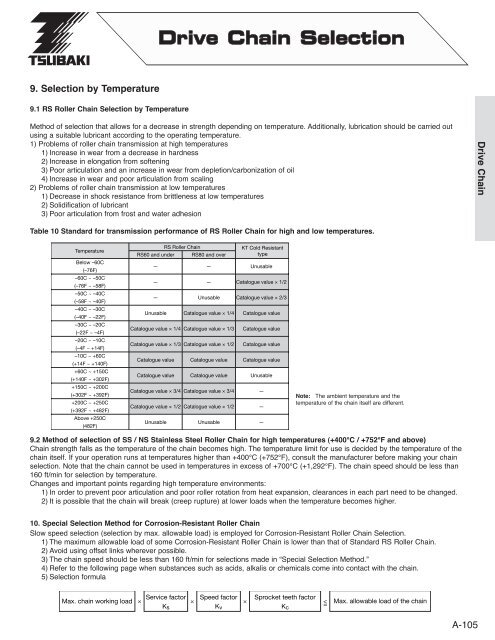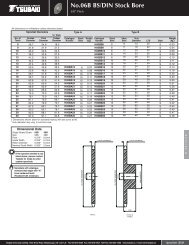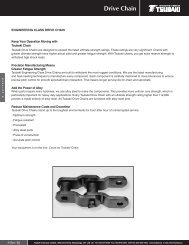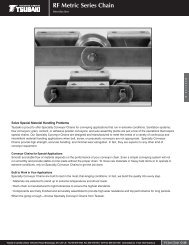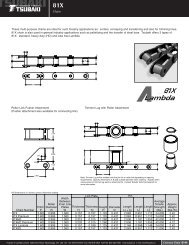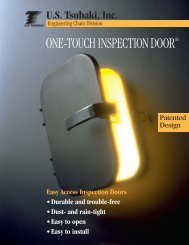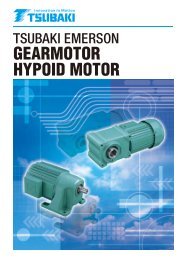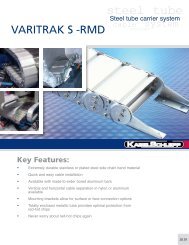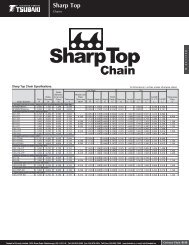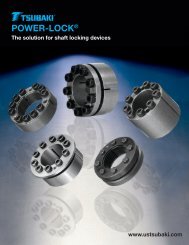Roller Chain - Tsubaki
Roller Chain - Tsubaki
Roller Chain - Tsubaki
Create successful ePaper yourself
Turn your PDF publications into a flip-book with our unique Google optimized e-Paper software.
Drive <strong>Chain</strong> Selection9. Selection by Temperature9.1 RS <strong>Roller</strong> <strong>Chain</strong> Selection by TemperatureMethod of selection that allows for a decrease in strength depending on temperature. Additionally, lubrication should be carried outusing a suitable lubricant according to the operating temperature.1) Problems of roller chain transmission at high temperatures1) Increase in wear from a decrease in hardness2) Increase in elongation from softening3) Poor articulation and an increase in wear from depletion/carbonization of oil4) Increase in wear and poor articulation from scaling2) Problems of roller chain transmission at low temperatures1) Decrease in shock resistance from brittleness at low temperatures2) Solidification of lubricant3) Poor articulation from frost and water adhesionDrive <strong>Chain</strong>Table 10 Standard for transmission performance of RS <strong>Roller</strong> <strong>Chain</strong> for high and low temperatures.TemperatureBelow –60C(–76F)–60C ~ –50C(–76F ~ –58F)–50C ~ –40C(–58F ~ –40F)–40C ~ –30C(–40F ~ –22F)–30C ~ –20C(–22F ~ –4F)–20C ~ –10C(–4F ~ +14F)–10C ~ +60C(+14F ~ +140F)+60C ~ +150C(+140F ~ +302F)+150C ~ +200C(+302F ~ +392F)+200C ~ +250C(+392F ~ +482F)Above +250C(482F)RS <strong>Roller</strong> <strong>Chain</strong>RS60 and under RS80 and over———UnusableCatalogue value × 1/4 Catalogue value × 1/3Catalogue value × 1/3 Catalogue value × 1/2Catalogue valueCatalogue valueCatalogue value × 3/4 Catalogue value × 3/4Catalogue value × 1/2 Catalogue value × 1/2Unusable——UnusableCatalogue value × 1/4Catalogue valueCatalogue valueUnusableKT Cold ResistanttypeUnusableCatalogue value × 1/2Catalogue value × 2/3Catalogue valueCatalogue valueCatalogue valueCatalogue valueUnusable———Note: The ambient temperature and thetemperature of the chain itself are different.9.2 Method of selection of SS / NS Stainless Steel <strong>Roller</strong> <strong>Chain</strong> for high temperatures (+400°C / +752°F and above)<strong>Chain</strong> strength falls as the temperature of the chain becomes high. The temperature limit for use is decided by the temperature of thechain itself. If your operation runs at temperatures higher than +400°C (+752°F), consult the manufacturer before making your chainselection. Note that the chain cannot be used in temperatures in excess of +700°C (+1,292°F). The chain speed should be less than160 ft/min for selection by temperature.Changes and important points regarding high temperature environments:1) In order to prevent poor articulation and poor roller rotation from heat expansion, clearances in each part need to be changed.2) It is possible that the chain will break (creep rupture) at lower loads when the temperature becomes higher.10. Special Selection Method for Corrosion-Resistant <strong>Roller</strong> <strong>Chain</strong>Slow speed selection (selection by max. allowable load) is employed for Corrosion-Resistant <strong>Roller</strong> <strong>Chain</strong> Selection.1) The maximum allowable load of some Corrosion-Resistant <strong>Roller</strong> <strong>Chain</strong> is lower than that of Standard RS <strong>Roller</strong> <strong>Chain</strong>.2) Avoid using offset links wherever possible.3) The chain speed should be less than 160 ft/min for selections made in “Special Selection Method.”4) Refer to the following page when substances such as acids, alkalis or chemicals come into contact with the chain.5) Selection formulaMax. chain working load×Service factorK s×Speed factor Sprocket teeth factor×


